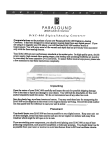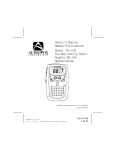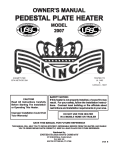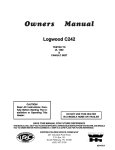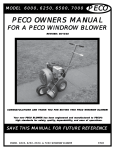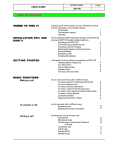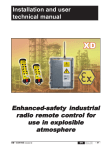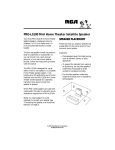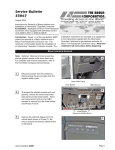Download OmniMount 20.0 W
Transcript
Mounting Options OPTION II: Before you begin, decide which mounting option and ball shaft are appropriate for your speaker speaker.. For Speakers That Require a Mounting Plate to AccessThreaded Inserts • You must affix the mounting plate to the ball shaft before attaching the mounting plate to the speaker: • Pick up the ball shaft and mounting plate. Insert the threaded end of the ball shaft into the top of the mounting plate until it butts up against the bottom of the jam nut. Fig. D 20.0 Speaker Mount Installation Instructions Before You Start Read This Section Carefully Tools Required To use the 20.0 Speaker Mount Kit, your speaker must meet ONE of You will need at least these tools for the installation the following criteria: • 5/32” hex wrench (supplied) • This mount is ONLY for speakers weighing up to 20lbs • Drill bits: ¼” (for drywall installation) or 5/16” (for wood and (9 kg). masonry surfaces) • Your speaker must have one of the following means of • 916”(11mm) open wrench or small crescent wrench securing the mount: • Phillips screwdriver, medium size • A factory installed 3/8”-16 threaded insert • Hammer • An electric drill • Factory installed, correctly spaced threaded inserts for use • Wire cutters with our mounting plate • Sturdy wood frame that can be safely drilled into and securely attached to our mounting plate with the #14 course thread screws provided. CAUTION: If you have any questions or concerns regarding the mounting of your speaker, contact a professional installer or the speaker manufacturer as necessary. KIT COMPONENTS AND THEIR USE The Clamp Assembly The clamp assembly consists of the clamp plate and jaw and attaches to your mounting surface (wall, ceiling, etc). The clamp assembly provides the clamping action that surrounds the ball and locks in the chosen angle of adjustment (fig. A) The Ball Shaft The ball shaft attaches to the speaker in the following ways. • Fig. C • Pick up the extra jam nut. Position it so that the circular part of the nut faces the end of the ball shaft protruding from the bottom of the mounting plate. Thread the nut onto the shaft a few turns only—until the top of the nut is even with the end of the ball shaft. (Fig. C) • Place the mounting plate on a flat surface and pull up on the ball shaft. Screw the top jam nut down against the top of the mounting plate. • Attach the mounting plate to the speaker by placing the slotted holes over the threaded insertsand tightening the screws. (Fig. D) • Using the 9/16” open end wrench or small crescent wrench, tighten the jam nut securely against the top of the mounting plate. OPTION III: For Wood Speakers with NO Threaded Inserts • You must affix the mounting plate to the ball shaft before attaching the mounting plate to the speaker: • Pick up the ball shaft and mounting plate. Insert the threaded end of the ball shaft into the top of the mounting plate until it butts up against the bottom of the jam nut. OPTION I: For Speakers With a 3/8”-16 Factory Installed Threaded Insert Insert the ball shaft and rotate it several turns until it is fully threaded into the threaded female insert on the speaker. When you Determine which format is Fig. A “hit bottom” back out the ball shaft one quarter turn (Fig. B). needed for your speaker: Fig. B • Using the 9/16” open wrench or crescent OPTION I— threads directly into the 3/8”-16 factory installed wrench, firmly tighten the jam nut, but threaded insert on the speaker DO NOT OVER-TIGHTEN. OPTION II– when mounting plate is necessary to access threaded • When the ball shaft resists moderate rotational inserts, the ball shaft attaches to the plate force and forms a solid joint with the OPTION III– wood speakers with no threaded inserts, the ball shaft speaker, stop tightening. attaches to the mounting plate which is attached to speaker with screws. Fig. E • Pick up the extra jam nut. Position it so that the circular part of the nut faces the end of the ball shaft protruding from the bottom of the mounting plate. Thread the nut onto the shaft a few turns only—until the top of the nut is even with the end of the ball shaft. • Place the mounting plate on a flat surface and pull up on the ball shaft. Screw the top jam nut down against the top of the mounting plate. (Fig. E) OPTION III: For Wood Speakers with NO Threaded Inserts NOTE: When no threaded inserts for mounting purposes have been provided by the speaker manufacturer, a speaker can still be safely mounted on the wall or ceiling. But you have to be sure that it is put together with materials strong enough to support its own weight with the #14 course thread screws provided. Most compact speakers are made well enough and use adequate materials thick enough for mounting with an OmniMount assembly. The #14 screws should not be used in Masonite®, thin panel wood or plastic. Such materials will likely require different fastening hardware and methods and possible reinforcement to be mounted safely. If your evaluation raises any questions about the speaker’s construction or material strength, contact your dealer or the speaker manufacturer and ASK QUESTIONS. • 20.0 Wall Mount— To mount on a wall, the mounting plate will be affixed to the back of the speaker. If you are mounting on a side wall, the mounting plate will be affixed to the side of the speaker. The 20.0 straight ball shaft can also be used for a ceiling application by affixing the mounting plate to the top of the speaker. • 20.0 Ceiling Mount— To mount to the ceiling, the mounting plate will be affixed to the back of the speaker. The 20.0 bent ball shaft can also be used for a wall application by affixing the mounting plate to the top or bottom of the speaker. OPTION IV: For Wood Speakers with NO Threaded Inserts • Place the speaker on a scratch-proof surface. Be careful to protect any exposed components from damage. Position the mounting plate at the chosen location on the speaker. Using the mounting plate as a template, with a pencil, mark the outline of the two slots on the surface of the speaker. STEP 3: STEP 2: ATT ACHING CLAMP ASSEMBL TTACHING ASSEMBLYY POSITIONING CLAMP ASSEMBL ASSEMBLYY • Insert the two anchors fully until the flange is flush against the mounting surface (Fig. J & K). • Position the clamp assembly over the anchors. • Insert and tighten the #12 coarse thread screws (provided). (Fig L). Use a Phillips screwdriver or a Phillips bit in a battery powered drive tool (Fig. M). Fig. M Ceiling or Floor Mounting The Wall Mount Ball Shaft may also be used to mount a speaker from the ceiling. For installation placement, see Fig. I-2. CAUTION: Be careful not to drill or screw into a speaker where you could possibly damage internal components. If there’s a question about this, check with your dealer or the manufacturer, or you may choose to carefully remove the driver and check inside the speaker enclosure yourself. • STEP 4: The clamp assembly should be positioned so that the clamp plate (with the OmniMount logo) faces in the same direction as the front of the speaker you are mounting. The jaw and the tension screw will face in the opposite direction (towards the wall) (fig O). Position the clamp assembly onto the wall, ceiling or floor at the mounting location you have selected. Remove the mounting plate from the speaker where you had been using it as a template. Insert the 3/32” drill Fig. F bit (provided) so that ½” sticks out of the end of your drill. • Position the drill bit ¼” down from the far end of the slot but centered in the middle of the slot. • Drill the pilot hole straight down into speaker. Repeat the procedure for the second slot location. (Fig. F). • Place mounting plate onto the speaker, insert the #14 screws and tighten until the Fig. G screws are firmly seated against the top of the mounting plate. Do not overtighten! (Fig. G). ATT ACHING CLAMP ASSEMBL TTACHING ASSEMBLYY Using the clamp plate as a template, mark the two holes with a pencil. Remove the clamp plate before drilling into your mounting surface. CAUTION: It may be necessary to check that the surface preparation and the fasteners will not interfere with electrical wiring, plumbing, etc., behind the mounting surface (wall, ceiling, or floor). Using the 7/16 open wrench or small crescent wrench, tighten the jam nut securely against the top of the mounting plate (Fig. H). Your OmniMount Speaker Mount is designed to be mounted on a variety of wall and ceiling constructions. Please follow all safety precautions listed here before installing the Clamp and Jaw Assembly. Fig. H POSITIONING CLAMP ASSEMBL ASSEMBLYY Wall Mounting Fig. I-2 STEP 3: • STEP 2: JOINING THE BALL SHAFT AND CLAMP ASSEMBL ASSEMBLYY CAUTION: Drilling holes into masonry or concrete material requires the use of a carbide tipped 5/16” (8mm) diameter masonry drill and/or hammer drill. Always wear eye protection. Mounting Onto Solid Wood or Masonry • Insert a 5/16” (8mm) diameter drill bit (not provided). Set depth of Position the clamp plate vertically the OmniMount Logo should be drill at a minimum 2 1/2” (63.5mm) protruding from the end of your facing toward the ceiling, the tension screw head faces towards the drill. floor (Fig. I). • Fig. I Center the drill on the marked hole locations and carefully drill the two holes to the minimum 2 ½” (63.5mm) depth. Fig. J Fig. K Fig. L • Check that the clamp assembly is open enough to accept the ball. Get the 5/32” (4 mm) hex wrench. Now lift the speaker into position and “pop” the ball into the clamp assembly. Set your chosen angle of adjustment. • While supporting the speaker, insert the long end of the hex key and turn the hex tension screw clock-wise to take up the slack in the clamp assembly, but do not fully tighten. (The ball should be properly seated, and the speaker should still move easily). (Fig. N). Caution: Tightest is not always the best! Over tightening fasteners can weaken the installation. Make sure the connection is extremely solid and then stop tightening. • If the speaker angle must be changed, do not attempt to move the speaker without first loosening the tension screw. Reposition, then tighten the tension screw further until the speaker is held firmly in place. • If rotational adjustment of the mounted speaker is required, the jam nut must first be loosened, the speaker rotated, and the jam nut tightened again. Use the 7/16” (11mm) open wrench or a small adjustable crescent wrench for this procedure. Caution: If the speaker loses its position, do not attempt to move the speaker without first loosening the tension screw. Reposition, then tighten the tension screw further until the speaker is held firmly in place. CONGRA TULA TIONS! CONGRATULA TULATIONS! YOUR INST ALLA TION IS NOW COMPLETE. INSTALLA ALLATION Fig. N ADJUSTING THE POSITION OF THE SPEAKER AND TIGHTENING THE CLAMP ASSEMBL ASSEMBLYY • Orient and hold the speaker in its final fixed position. CAUTION: The weight of the speaker must be fully supported throughout the entire tightening process. Do not allow the ball shaft to rest upon or push against the clamp assembly. Two installers may be needed for this; one to support the speaker while the other tightens the clamp assembly. Note: The following is made in lieu of all warranties expressed or implied. The Manufacturer’s only obligation shall be to replace parts of this product proved to be defective within two years of the date of purchase. We are aware that this mounting assembly may be used for purposes and in ways other than those for which it had been designed and manufactured. The Manufacturer, Distributor, Retail and their respective agents cannot be held responsible or liable for injuries or property damage— direct, indirect, or consequential—arising out of the use, or inability to use this product safely and properly. Note: Every effort has been made to provide accurate and errorfree assembly and installation information. Omnimount Systems disclaims liability for any difficulties arising from the interpretation of information contained in these instructions. • Insert the hex key into the tension screw head and tighten (Fig. O) • Pick up the vice grip pliers, regular pliers, or small crescents wrench and use one of these Fig. O tools to assist in tightening the tension screw. Tighten in ½ turn increments until the speaker is firmly held in place. • NOTE: To hold the speaker in position and prevent any slippage, the clamp assembly must get a good “bite” into the ball and form a SOLID joint. The clamp assembly needs to be tightened enough to lock and hold the speaker FIRMLY at the chosen angle. When that point is reached, no further tightening is necessary. Omnimount Systems, Inc. 8201 South 48th Street Phoenix, AZ 85044-5355 Voice: 480-829-8000 Fax: 480-756-9000 Email: [email protected] Web: www.omnimount.com Copyright 2002, Omnimount Systems, Inc. All rights reserved. OmniMount products are covered by patents issued and/or pending. “OmniMount” is a registered trademark of Omnimount Systems, Inc. OmniMount products are manufactured in the USA. Printed In the USA. 20.0 speaker mount kit Rev 03/02


